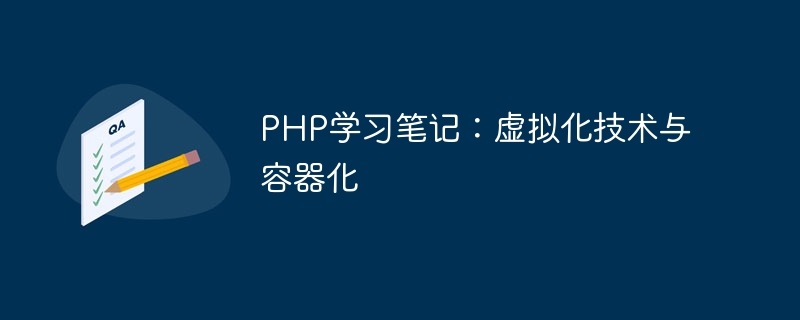Home >Backend Development >PHP Tutorial >PHP study notes: virtualization technology and containerization
PHP study notes: virtualization technology and containerization
- WBOYWBOYWBOYWBOYWBOYWBOYWBOYWBOYWBOYWBOYWBOYWBOYWBOriginal
- 2023-10-10 11:09:201264browse

PHP study notes: virtualization technology and containerization
With the advent of the era of cloud computing and big data, software development and deployment methods are also undergoing revolutions The change. The traditional server architecture can no longer meet the growing user needs and system scale. Virtualization technology and containerization have become hot topics in software development and deployment today. In this article, we will explore how to use virtualization technology and containerization in PHP development through specific code examples.
First of all, we need to understand the concepts of virtualization technology and containerization. Virtualization technology refers to the technology that divides a physical computer into multiple independent virtual computer environments. Each virtual machine can run an independent operating system and have independently allocated resources. Containerization is a lightweight virtualization technology that provides an independent running environment for applications. Multiple containers can share the same operating system kernel, thereby improving resource utilization and operating efficiency.
Next, we will use a specific example to introduce how to use virtualization technology and containerization in PHP development.
Suppose we are developing a simple message board application. We use PHP to write the backend logic and MySQL as the database. We want to deploy the application into a virtualized environment and manage it using containerization technology.
First, we need to install the virtualization platform. In this example, we use VMware to create the virtual machine. We can download and install VMware Workstation from the VMware official website. Once the installation is complete, we can create a new virtual machine and install the appropriate operating system.
Next, we need to install the containerization engine. In this example, we use Docker as the containerization engine. We can download and install Docker on the Docker official website. Once the installation is complete, we can verify that the installation was successful with the following command:
docker --version
Next, we need to create a Dockerfile that describes how to build our application container. In this example, our Dockerfile is as follows:
FROM php:7.4-apache COPY . /var/www/html EXPOSE 80
The above Dockerfile first specifies the base image as php:7.4-apache, which already contains PHP and Apache servers. It then copies all files in the current directory to the container's /var/www/html directory. Finally, it maps the container's port 80 to the host's port 80 so that we can access the application through the browser.
Next, we can use the following command to build and run the container:
docker build -t myapp . docker run -p 80:80 myapp
The above command will use the Dockerfile to build an image named myapp and map the container's port 80 to the host Port 80 of the host. Then, it will run the image.
Now, we can view our application by accessing http://localhost through the browser, it should be running in a separate container.
Through the above examples, we can see that virtualization technology and containerization bring a lot of convenience to software development and deployment. They can provide an independent running environment to help us better manage and expand applications. In addition, virtualization technology and containerization can also improve resource utilization and operational efficiency.
Of course, this article is just a brief introduction to virtualization technology and containerization. There is more content that needs to be learned and mastered in practical applications. I hope this article can provide an introductory guide for beginners, stimulate everyone's interest in virtualization technology and containerization, and discover more possibilities in practical applications.
The above is the detailed content of PHP study notes: virtualization technology and containerization. For more information, please follow other related articles on the PHP Chinese website!
Related articles
See more- PHP study notes 2
- Reasons why the database is not suitable for docker and containerization
- How to manage containerization of Python applications using Kubernetes
- How to use virtualization technology in Java to achieve application isolation and resource management?
- How to use Go language for containerized deployment

